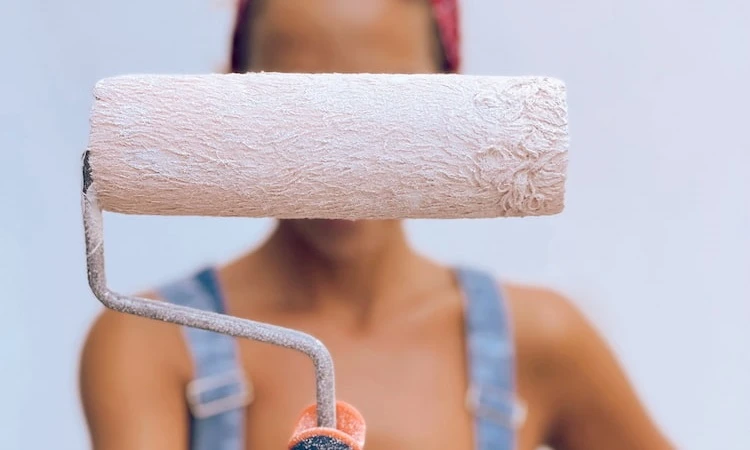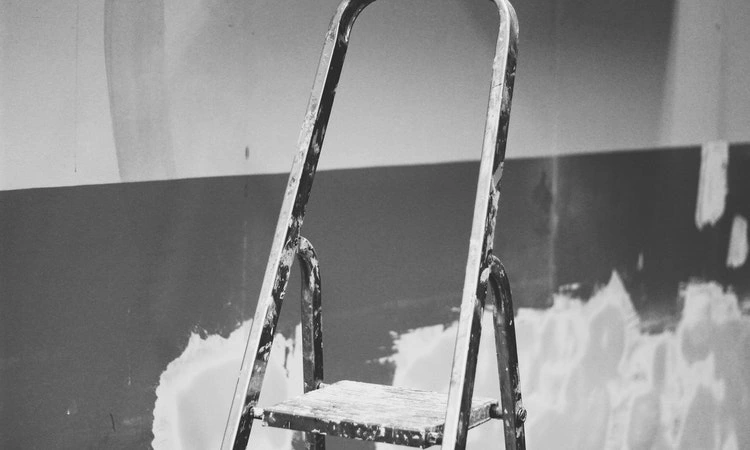Are you thinking about painting the windows of your business or home? Glass windows that are painted can be a great way to decorate for holidays.
It can also be a great way to advertise sales or show your artistic skills to your neighbors.
Painting glass is a relatively easy process. You simply have to start by cleaning the glass. Then you will tape off the area you do not want to be painted. You can stencil your design and begin painting. Sounds pretty easy, right?
To be honest, a little more goes into it, but that is the general process. I bet you would not think to wear gloves while painting glass, would you? That is where I step in to help you.
You should continue reading this article to discover all the ins and outs of painting glass windows.
I will also provide some top paints you can use to paint your glass windows.
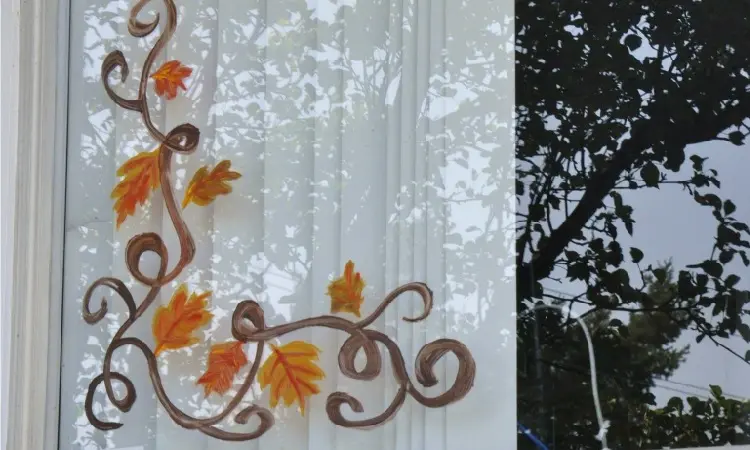
Can You Paint Directly on Glass?
Whether decorating your business’s window or home window, you can easily paint directly onto your glass windows.
It is very easy to create beautiful masterpieces on glass. You will have to perform minor prep work, but I will explain later.
How Do You Prepare Glass for Painting?
It is important to clean glass before you paint it. Glass is prone to smudges and grease.
These things can make it difficult for any paint to adhere to glass. While you clean the glass, you should wear gloves.
The idea is to remove grease from the surface. If you are not wearing gloves, you could apply more grease even after cleaning the surface.
You can use a clean rag or paper towel with soap and water to remove dirt and debris from the glass. You can also use any normal window cleaner to clean the glass.
Once you have scrubbed the glass clean, it is recommended to wipe the surface with rubbing alcohol. The rubbing alcohol will ensure all dirt has been removed from the glass.
The rubbing alcohol will also remove any chemicals you left while cleaning the window. You should let the glass dry for a couple of hours before painting it.
Do You Need to Prime the Glass Before Painting?
Primer does not necessarily have to be applied to glass before painting it.
However, if you use acrylic paint and want the design to be permanent, you should use gesso.
Gesso will prepare the surface and allow the paint to adhere better to the glass.
Most gesso options are white. You should keep this in the back of your mind when choosing whether to use a primer or not.
Most forms of primer will give the glass a frosted appearance. This should not be a concern if you are going to paint the entire surface of the glass.
However, if you are not painting the entire surface, you may not want the frosted appearance behind your design. Do not worry too much about using some kind of primer.
Again, it is unnecessary, but it can benefit long-lasting projects.
What Kind of Brush Do You Use for Glass Painting?
There are several different brushes you can use for painting on glass. Ultimately, which brush you choose depends on what kind of design you want.
Synthetic brushes will often leave brush strokes. In contrast, natural or sponge brushes will create a more consistent look.
No matter what type of brush you choose, make sure you pick a high-quality brush.
Cheaper brushes are more likely to lose their hair in your paint. The last thing anyone wants is paintbrush hairs in their beautiful designs.
What Kind of Paint Can You Use on Glass Windows?
There are a couple of different kinds of paint you can use on glass windows. Before choosing what kind of paint you want, you need to know how long your design will last.
If you are painting pumpkins for Halloween, you probably want the pumpkins gone by Christmas.
For temporary and kid-friendly projects, you should use tempera paint. It comes in a wide variety of bright and vibrant colors. It is also a temporary and washable paint.
Tempera paint is the best for projects with your kids as this paint is allergen and toxin-free.
You can also use latex paints on glass. Latex paints are not permanent when they are painted on glass surfaces. These paints can be easily washed or peeled away.
You will often need multiple coats of latex paint as glass windows lack the texture for the paint to adhere properly.
You can use normal acrylic paint on glass. Acrylic paint will adhere to the glass, but you may want to use a medium to help seal it.
A medium will help the paint last longer. Acrylic paints provide a matte finish when they are painted on glass.
Acrylic enamel is one of the best paints for glass windows. This kind of paint is also used for painting cars. It offers full coverage, and it is permanent when it is painted on glass.
The only downside to acrylic enamel is that it can be more expensive than normal acrylic paints.
Paints that have been specially formulated for glass are a great option as well. They can be acrylic, chalk, or other water-based paints.
You should remember that not all of them will be long-lasting paints. You will have to read the instructions to verify how long the paint can last on glass windows.
| Type of Paint | Permanent | Not Permanent |
|---|---|---|
| Tempera Paint | ✖ | ✔ |
| Latex Paint | ✖ | ✔ |
| Acrylic Paint | ✔ | ✖ |
Glass Windows Painting Process Step by Step
Now, it is time to get into how to paint glass windows. I previously mentioned wearing gloves while you prepare the surface of the glass.
Well, you should continue wearing gloves throughout the painting process.
It can be difficult to wear gloves while painting, but it is better for your artwork. You can easily get oil and dirt on the glass if you are not wearing gloves.
That can, in turn, make it more difficult for the paint to adhere to the glass.
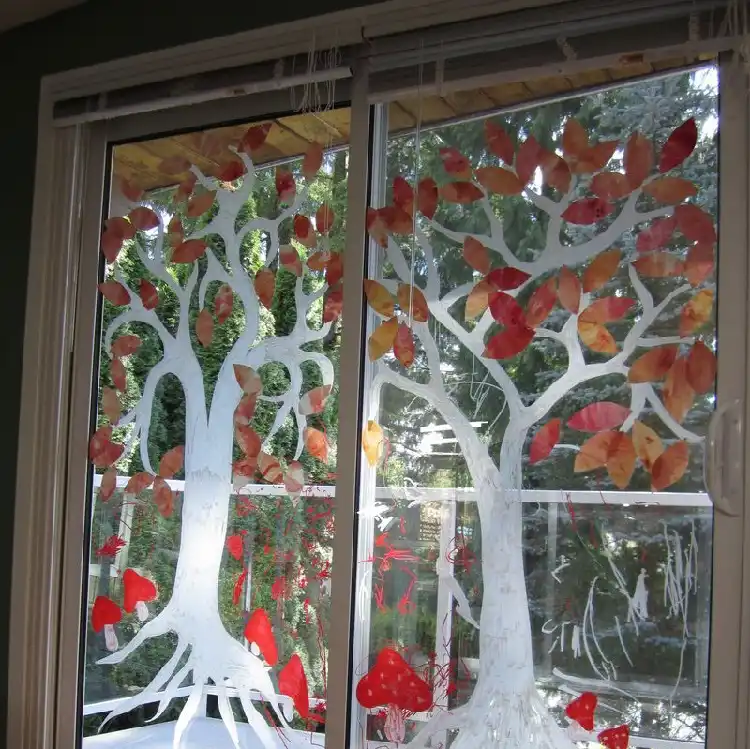
Step 1: Clean the Glass
You should start your project by cleaning the surface of the glass. Remember to use lukewarm water and soap to scrub the surface.
This will remove any obvious dirt and debris. Then use rubbing alcohol to wipe down the surface.
The rubbing alcohol will help remove any remaining dirt and grime you cannot see.
Rubbing alcohol can thin and remove paint. Therefore, you must let the glass thoroughly dry before painting it.
Step 2: Tape Around the Window
After the glass window dries, you should use painter’s tape to create borders around the window. This will prevent you from painting the walls.
You can also use painter’s tape to tape off areas on the window that you do not want to be painted.
Once your borders are set up, you can apply your primer or background color.
You should let the paint thoroughly dry before continuing to the next step. This will prevent the paint from your design from blending with the primer or background color.
Step 3: Apply Your Stencil or Design
Once your background or primer is fully dried, you can begin to paint your design. You can use a marker or paint liner to outline your design.
If you did not paint the background or the background is slightly opaque, you can tape a sketch of your design to the other side of the window.
Step 4: Paint Your Glass
Let your imagination and creativity come out as you begin to paint your design. You should begin painting in the top left corner if you are right-handed.
In contrast, you should begin painting in the top right corner if you are left-handed.
Then you can work your way across and down the painting. This will help prevent you from smudging your artwork.
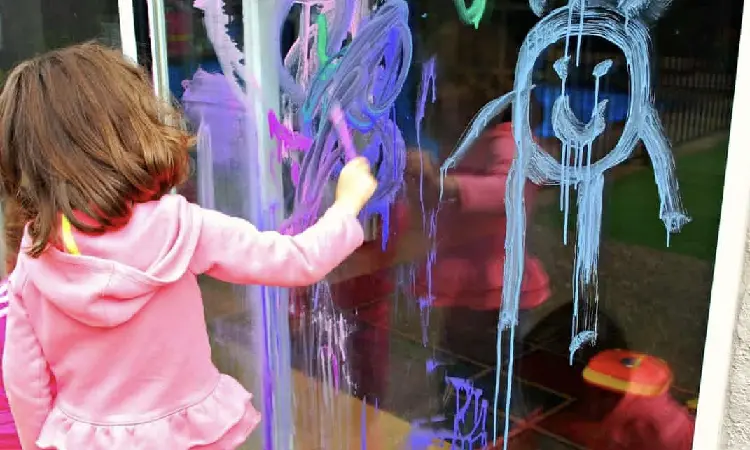
You should only paint one color at a time. For instance, if you paint with blue, make sure you paint everything that will be blue before you start painting with another color.
You must let each color dry before moving on to the next color. If the paint is still wet, your colors will begin to blend.
Tempera paint and other water-based paints should be dry within minutes. On the other hand, enamel paints will require 8 to 24 hours to dry completely.
As long as the paint is dry to the touch, you can begin using the next color.
You may also need to apply multiple layers of each color. Some colors may not dry as dark as you would like.
Pro tip: It is beneficial to have a towel or rag nearby. This can be used to remove unwanted mistakes quickly. It will be easier to remove the mistakes while the paint is still wet instead of waiting for it to dry.
Some permanent paints, such as acrylic enamel paints, can be difficult to remove.
You may need paint thinner on the cloth to allow for easy removal.
Step 5: Cure the Paint
The paint needs time to cure. While the paint is curing, it will be susceptible to chipping and peeling very easily. With smaller glass painting projects, many people will recommend baking the paint.
However, it is not possible to bake your glass window.
You may be told to use a hairdryer to try to cure the paint. You can certainly try to use a hairdryer.
However, many suggest that a hairdryer does not fully produce enough heat to cure a glass window. So what else can you do?
Unfortunately, the only thing you can do is leave the glass window painting alone. It is suggested to let the painted glass dry for approximately one month to cure fully.
During this time, you should refrain from cleaning the window. You should also try to limit the amount of water that gets on the window as this can ruin the paint.
How Do You Keep Paint From Peeling off the Glass?
The best and easiest way to keep paint from peeling off a window is to use a painting medium, such as gesso.
Some paints specifically designed for glass will already contain a medium in them. This allows the paint to adhere to the surface of the glass properly.
Another great way to keep the paint from peeling is to allow time for the paint to cure.
Many of us struggle with impatience, but the longer you leave the paint alone, the longer it should last on your window. Just try to keep your children from touching it as well.
The Best Primer for Glass Windows
As I have previously mentioned, applying a primer to the glass is unnecessary before painting it.
However, if you want the paint to last, you will want to apply a layer of primer to the glass before painting it.
You will also want to apply a primer when you use acrylic paints.
Here are the two top primers for glass windows that I recommend:
- U.S. Art Supply Geso: This is a lightweight, non-toxic acrylic paint medium. This company sells the gesso in white or black. It can also be mixed with acrylic paints to open up various color options.
- Liquitex BASIC Gesso: This brand has a few different size options. The size options make it great for those who require a lot or only a little. You can also mix it with other paint colors.
Best Paint for Glass Windows
Remember, there is a variety of paints you can use to paint glass. You should choose the type of paint based on how permanent you want your project to be. Below, I have listed the top three paints for painting glass windows.
- Artistro’s Paint Pens: These pens are acrylic-based. They are a great option for those who may not like using paintbrushes. They allow you to provide more details in your work that can be hard to achieve with a paintbrush.
- Folkart’s Enamel Paint: This set comes with 16 beautiful color options. The paints have a gloss finish, and they are dishwasher-safe paints. So after you paint your window, you can try painting glass cups or other glass dishes.
- Tempera Paint Set: This is the best paint if your kids are going to be helping you with your project. Tempera paint is a very kid-friendly paint. It will not permanently stay on your windows, making it the best paint for holiday window decorations.
FAQs: Painting Glass Windows
So you know how to paint glass now. You also know some of the top paints to use.
What else could you possibly need to know?
There are a couple of other things people routinely ask before or during their glass window painting project.
1. Does Spray Paint Stick to Glass?
Spray paint will stick to the glass. It is one of the best options for having big and broad areas to paint.
Spray paint can cover square footage than your normal acrylic and water-based paints.
Spray paint is a great option for painting the background of your window. It allows you to cover a large area in a short amount of time.
If your spray paint is water-based, ensure the other paint you use is also water-based. Water and oil-based paints will not work well together.
You will have to apply multiple layers of spray paint. In general, spray paint is very thin. You will not need as much paint if you want an opaque design.
However, if you want full coverage with little light coming through, you must apply several layers.
2. Will Acrylic Paint Come off Windows?
You can use acrylic paint on smooth surfaces such as glass. Unfortunately, it can show wear and tear easier than other paints.
This is why you should use acrylic enamel paint or regular acrylic paint with a painting medium.
The medium will allow the paint to adhere better and make it more durable.
But what if you did not mean to paint your windows, or at least not that particular area? If the paint is still wet, you can easily wipe it away with water and soap on a washcloth.
You can also use a vinegar and water solution or paint thinner to remove the acrylic paint from the glass.
3. Can You Paint Glass With Chalk Paint?
It is possible to use calk paint to paint on glass. There are even chalk paints specifically designed for use on glass.
You must ensure the glass is clean and thoroughly degreased before painting it.
4. How Do I Make Sure Acrylic Paint Will Stay on Glass?
The use of an acrylic medium such as gesso can be used to help ensure the acrylic paint will stay on the glass.
Any painting medium can be applied to the glass as a primer before you begin painting. It will allow the paint to bond better to the glass.
5. How Do You Paint Glass Without Brush Strokes?
If you do not want brush strokes on glass, you need to use a natural paintbrush. Synthetic paintbrushes will leave stoke marks on the paint.
You can also use a sponge brush. Sponge brushes can add texture without visible brush strokes.
6. How Do You Remove Paint From Glass
Water-based paints can be removed from the glass with soap and water on a clean rag.
Acrylic paints will require a little bit more effort to be removed. You will need to mix three tablespoons of water and vinegar.
A rag can then be dipped into the mixture and used to scrub the paint away.
You may need the help of a dull razor to remove the tough patches of paint. You should hold the razor at an angle to decrease the risk of scratching the surface of the glass.
Verdict
I did warn you that there was a bit more to painting glass than what meets the eye. All in all, it is still a relatively simple process.
Just clean, tape, and paint your design. The most important step is to let the paint dry between colors. Whether you want a permanent display or you want to advertise a sale in your business, you can paint glass windows.
Just be mindful of what paint you use for your glass window. Again some paints are permanent, while others are easily washed away.


